With time approaching 10.20 am Sumitra has everything prepared. A statue of the Buddha has been carefully transported from the country house to the Pelawatta house. Before it was transported a new toothbrush had to be bought with which to clean and scrub the Buddha so it is pristine for the ceremony. The statue sat in the front passenger seat of the car until we were ready to leave and was carefully cradled throughout the journey.
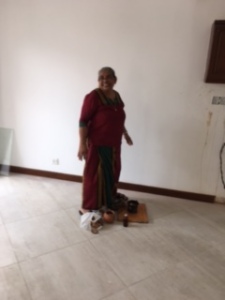 The new clay pot, filled with coconut milk, ground and liquidised from coconuts grown at the country house, is set on top of a metal stand underneath which is a ceramic tile to protect the newly tiled kitchen floor. The dried coconut palm leaves are folded to fit under the pot and set alight. They are so dry that it is easy for them to catch fire.
The new clay pot, filled with coconut milk, ground and liquidised from coconuts grown at the country house, is set on top of a metal stand underneath which is a ceramic tile to protect the newly tiled kitchen floor. The dried coconut palm leaves are folded to fit under the pot and set alight. They are so dry that it is easy for them to catch fire.
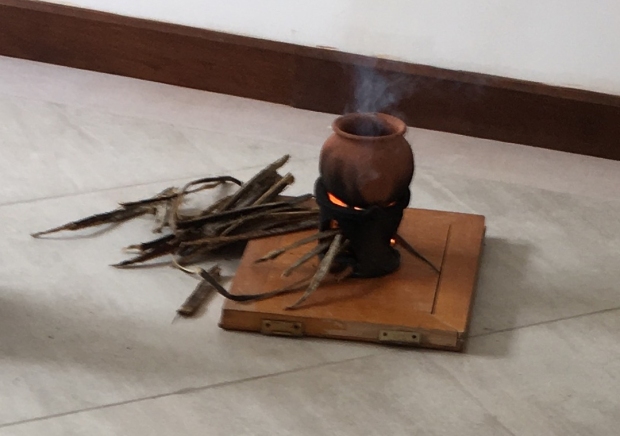 We wait, and wait and wait for the milk to boil over. The new red clay pot becomes blackened in the flames and the fire is fed some more palm leaves. Everyone, family, workmen and the newly arrived air conditioning installers from Singers, come to hover over the pot, almost willing it to bubble up and boil over.
We wait, and wait and wait for the milk to boil over. The new red clay pot becomes blackened in the flames and the fire is fed some more palm leaves. Everyone, family, workmen and the newly arrived air conditioning installers from Singers, come to hover over the pot, almost willing it to bubble up and boil over.
It takes its own time and eventually does.
The boiling over of the milk represents a household which will always have plenty and never be short of anything.
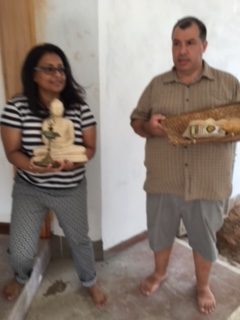 Ceremoniously the couple enter the house, she carrying the statue of the Buddha and a brass oil burner and he carrying a basket with food.
Ceremoniously the couple enter the house, she carrying the statue of the Buddha and a brass oil burner and he carrying a basket with food.
This is taken upstairs and set out neatly, the oil lit in the brass oil burner and the white flowers offered to the Buddha
.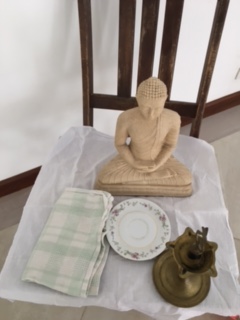
Sumitra swings what seems like incense around the house in great clouds and then goes to each corner of the house to sprinkle drops of the cooled boiled milk.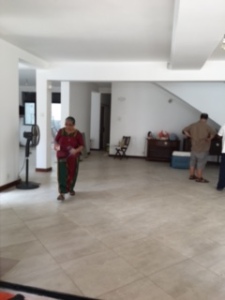
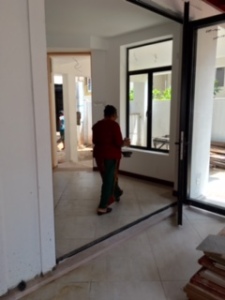
Gate Late, the builder, presents the couple with buffalo curd and palm syrup. Likewise Sumitra’s other daughter has sent similar gifts to bless the occasion as it is the custom to present milk products at these ceremonies.
Now the furniture comes in and some of the builder’s workmen help transport it to the different rooms and floors.
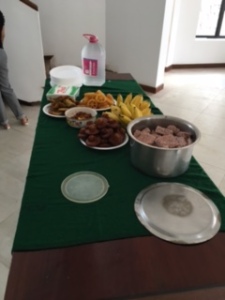 Sumitra’s earlier cooking is laid out for all to share. There’s the white rice and coconut which the locals ball into a perfect round with their finger tips. There’s a bowl of some reddish mixture which I am warned not to touch as it will be too spicy for me and there are several sweet treats, of different flavours as well as biscuits and bananas, again the small four inch fat ones which taste delicious. Fresh tea is made and cups and glasses are filled and shared and some choose only to drink water.
Sumitra’s earlier cooking is laid out for all to share. There’s the white rice and coconut which the locals ball into a perfect round with their finger tips. There’s a bowl of some reddish mixture which I am warned not to touch as it will be too spicy for me and there are several sweet treats, of different flavours as well as biscuits and bananas, again the small four inch fat ones which taste delicious. Fresh tea is made and cups and glasses are filled and shared and some choose only to drink water.
When the workmen on the upper floors are called down to share the feast they come down the curved staircase in single file and walk past the food into the downstairs cloakrooms where they wash and dry their hands before coming back into what will be the large sitting room, to eat.
The glass doors to this room are two four panelled floor to ceiling doors, which fold back completely. The adjoining veranda is shaded by a large wooden canopy which gives shelter from the sun, and some privacy.
Here, in this multi populated island and especially in this area, space is expensive and at a premium and we are cheek by jowl beside other houses. For all that it is very quiet although the son says he has soundproofed my bedroom in order to give the neighbours some peace as I am always singing around the house.
I wonder what on earth is going on now when I see the daughter-in-law start stabbing the red earth around the house with what looks like a metal pole – there is not much garden here and I can’t understand what she is doing digging up what is there. It is explained that the Monk – and they have another name for a Monk who advises on the Most Auspicious times – has given them little bottles filled with precious oil and these must be buried around the grounds of the house to protect it and its residents from harm.
Eventually this morning’s early awakening takes it toll and we flop one by one on the large leather sofas brought over in the lorry. Sumitra is especially tired as the whole ceremony and the earlier cooking has been laid on her shoulders.
But it has been a job well done as the fire lit, the milk boiled over, there was more than enough food to sate everyone’s appetite, even though there were more workmen present than expected, but there is more to come on this busy day before arrive back at the country house very late that same evening.


